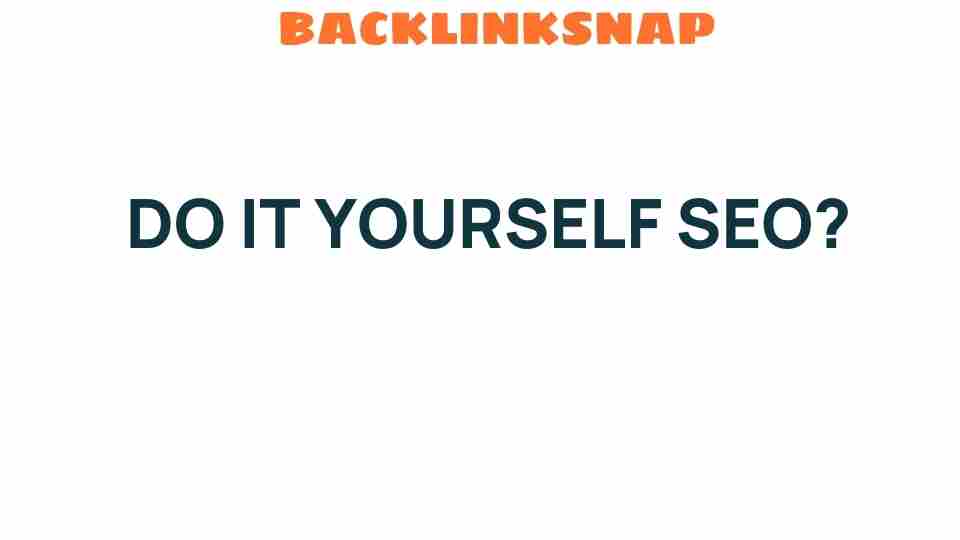Unlocking the Secrets of DIY SEO: Transform Your Website Today
In today’s digital landscape, having a website is just the beginning. The real challenge lies in ensuring that your site stands out amidst a sea of competitors. This is where DIY SEO comes into play. By understanding the fundamentals of search engine optimization, you can enhance your website’s visibility, drive more traffic, and ultimately achieve your online goals. In this article, we’ll delve into essential DIY SEO strategies that can transform your website and boost your digital marketing efforts.
What is DIY SEO?
DIY SEO refers to the practice of optimizing your website for search engines without hiring a professional SEO service. It encompasses various techniques and strategies aimed at improving your website’s ranking on search engine results pages (SERPs). With the right knowledge and tools, anyone can implement effective SEO strategies to increase their website traffic and online visibility.
Why is SEO Important?
Search engine optimization is crucial for several reasons:
- Increased Traffic: Higher rankings on search engines lead to more organic traffic.
- Better User Experience: SEO involves optimizing your website’s structure and content, making it more user-friendly.
- Cost-Effective Marketing: Compared to paid advertising, SEO is more sustainable and offers long-term benefits.
- Brand Credibility: Websites that rank higher are often perceived as more trustworthy by users.
Essential DIY SEO Techniques
Now that we understand the importance of DIY SEO, let’s explore the key techniques that can help you transform your website:
1. Keyword Research
Keyword research is the backbone of search engine optimization. It involves identifying the terms and phrases that potential customers use to search for your products or services. Here’s how to conduct effective keyword research:
- Use tools like Google Keyword Planner, SEMrush, or Ahrefs to find relevant keywords.
- Look for long-tail keywords that are less competitive but highly targeted.
- Analyze competitors to see which keywords they are ranking for.
2. Content Strategy
Once you have your keywords, the next step is to develop a solid content strategy. Quality content is key to engaging your audience and keeping them on your site longer. Here are some tips:
- Create Valuable Content: Focus on providing informative and engaging content that addresses your audience’s needs.
- Use Keywords Wisely: Integrate your target keywords naturally within your content, headings, and meta descriptions.
- Update Regularly: Keep your content fresh and relevant by regularly updating existing pages and adding new content.
3. On-Page SEO
On-page SEO involves optimizing individual web pages to rank higher and earn more relevant traffic. Key aspects include:
- Title Tags: Ensure that your title tags are catchy and include your target keywords.
- Meta Descriptions: Write compelling meta descriptions that summarize your content and include keywords.
- Header Tags: Use H1, H2, and H3 tags to structure your content and improve readability.
4. Backlinking
Backlinking, or acquiring links from other websites to yours, significantly impacts your site’s authority and search ranking. Here are some effective backlinking strategies:
- Guest Blogging: Write articles for reputable blogs in your industry and include links back to your site.
- Engage in Online Communities: Participate in forums and social media groups where you can share your expertise and link to your site.
- Create Shareable Infographics: Develop visually appealing infographics that others may want to share, providing link opportunities.
5. Utilizing SEO Tools
There are numerous SEO tools available that can help you streamline your optimization efforts. Some of the most popular include:
- Google Analytics: Track your website traffic and user behavior.
- Yoast SEO: A WordPress plugin that helps optimize your content for search engines.
- Ahrefs: A comprehensive tool for keyword research, backlink analysis, and competitor research.
6. Monitoring and Adjusting Your Strategy
SEO isn’t a one-time task; it requires ongoing monitoring and adjustments. Regularly review your site’s performance using analytics tools, and be prepared to tweak your strategies based on what you learn. This iterative process is vital to maintaining and improving your search rankings.
FAQs About DIY SEO
1. How long does it take to see results from DIY SEO?
Results can vary, but typically, you may start seeing changes in your website traffic and rankings within 3 to 6 months of implementing SEO strategies.
2. Do I need to know coding to do DIY SEO?
No, you don’t need coding knowledge for basic SEO. Most platforms, like WordPress, offer user-friendly tools for optimizing your site.
3. Can I do SEO without hiring an expert?
Absolutely! Many businesses successfully implement DIY SEO strategies without hiring professionals. With the right resources and commitment, you can achieve great results.
4. What are the most important ranking factors for SEO?
Some key ranking factors include content quality, keyword usage, website speed, mobile-friendliness, and backlink quality.
5. Is local SEO different from traditional SEO?
Yes, local SEO focuses on optimizing your online presence to attract more business from relevant local searches. This includes managing your Google My Business listing and gathering local reviews.
6. How often should I update my content for SEO purposes?
It’s wise to review and update your content regularly, at least every few months. Fresh content can keep your audience engaged and improve your search rankings.
Conclusion
Unlocking the secrets of DIY SEO can truly transform your website and enhance your online visibility. By focusing on keyword research, developing a robust content strategy, optimizing your on-page elements, building backlinks, and utilizing effective SEO tools, you can significantly increase your website traffic and brand credibility. Remember, SEO is an ongoing process, and staying informed about the latest trends and strategies will set you apart from the competition. So, roll up your sleeves and get started on your DIY SEO journey today!
For further reading on SEO best practices, check out this comprehensive guide to SEO. If you’re looking for SEO tools, visit SEMrush for great options!
This article is in the category SEO Optimization and created by BacklinkSnap Team




